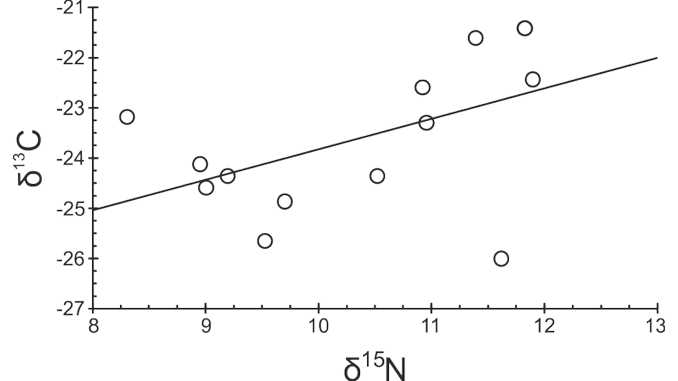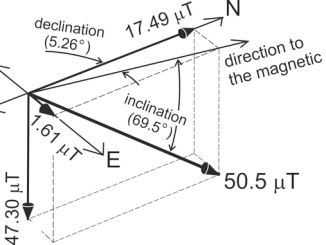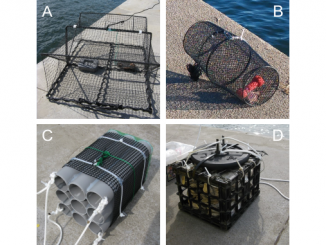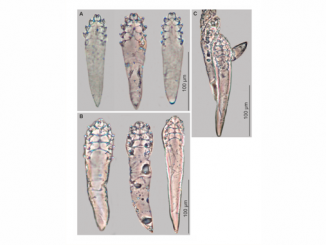
Paper category: Original research paper
Corresponding author: Andrzej Reindl (andrzej.reindl@ug.edu.pl)
DOI: 10.1515/ohs-2020-0014
Received: 25/08/2019
Accepted: 21/10/2019
Full text: here
Citation (APA style): Oceanological and Hydrobiological Studies, Volume 49, Issue 2, Pages 147–156, eISSN 1897-3191, ISSN 1730-413X, DOI: https://doi.org/10.1515/ohs-2020-0014.
Abstract
Muscles and livers of herring gulls (Larus argentatus) found in the coastal area of the southern Baltic Sea were tested for the presence of hexabromocyclododecane (HBCD) isomers. They were detected in the muscles (ΣHBCD = 42.82 ± 30.65 ng g−1 l.w.) and livers (ΣHBCD = 65.51 ± 27.96 ng g−1 l.w.) of all examined gulls. The α-HBCD isomer dominates in all types of samples. Our study has shown that bodies of gulls are less contaminated with HBCD than bodies of aquatic birds from other regions of the world. There was no clear correlation between HBCD concentrations and sex and age of birds. Nevertheless, it was indicated that the highest concentrations of ΣHBCD and the α-HBCD isomer were found in the livers of immature females (mean = 89.31 ± 21.63 ng g−1 l.w. and mean = 76.72 ± 24.54 ng g−1 l.w., respectively). The highest liver sequestration rates of the α-HBCD isomer were found in both adult and immature males (mean = 7.7 ± 13.7 and mean = 6.2 ± 11.9, respectively).
References
Abdallah, M.A.E., Uchea, C., Chipman, J.K. & Harrad, S. (2014). Enantioselective biotransformation of hexabromocyclododecane by in vitro rat and trout hepatic sub-cellular fractions. Env. Sci. Tech. 48(5): 2732–2740.
Alaee, M., Arias, P., Sjödin, A. & Bergman, A. (2003). An overview of commercially used brominated flame retardants, their applications, their use patterns in different countries/regions and possible modes of release. Environ Int. 29: 683–689.
Bignert, A., Berger, U., Boalt, E., Borg, H., Danielsson, S. et al. (2011). Comments Concerning the National Swedish Contaminant Monitoring Programme in Marine Biota. Report to the Swedish Environmental Protection Agency.
Bignert, A., Danielsson, S., Faxneld, S. & Nyberg, E. (2016). Comments concerning the national Swedish contaminant monitoring programme in marine biota, 2016. https://www.diva-portal.org/smash/get/diva2:908725/FULLTEXT01.pdf
Braune, B.M., Mallory, M.L., Gilchrist, H.G., Letcher, R.J., & Drouillard, K.G. (2007). Levels and trends of organochlorines and brominated flame retardants in Ivory Gull eggs from the Canadian Arctic, 1976 to 2004. Sci. Tot. Environ. 378(3): 403–417.
Braune, B.M., & Norstrom, R.J. (1989). Dynamics of organochlorine compounds in herring gulls: III. Tissue distribution and bioaccumulation in Lake Ontario gulls. Environ. Toxicol. Chem. 8(10): 957–968.
Chen, D., Letcher, R.J., Burgess, N.M., Champoux, L., Elliott, J.E. et al. (2012). Flame retardants in eggs of four gull species (Laridae) from breeding sites spanning Atlantic to Pacific Canada. Environ. Poll. 168: 1–9.
Covaci, A., Gerecke, A.C., Law, R.J., Voorspoels, S., Kohler, M. et al (2006). Hexabromocyclododecane (HBCDD) in the environment and humans: A review. Environ. Sci. Technol. 40: 3679–3688.
de Boer, J., Leonards, P.E., Kwadijk, C.J., Kruijt, A.W., Brandsma, S.H. et al. (2003). Screening and time trend study of decabromodiphenylether in birds (No. C051/03). RIVO.
de Wit, C.A. (2002). An overview of brominated flame retardants in the environment. Chemosphere 46: 583–624 .
de Wit, C.A., Herzke, D. & Vorkamp, K. (2010) Brominated flame retardants in the arctic environment – trends and new candidates. Sci. Tot. Environ. 408(15): 2885–2918.
Elliott, J.E., Wilson, L.K. & Wakeford, B. (2005). Polybrominated diphenyl ether trends in eggs of marine and freshwater birds from British Columbia, Canada, 1979−2002. Environ. Sci. Tech. 39(15): 5584–5591.
El-Mekkawi, H., Diab, M., Zaki, M., & Hassan, A. (2009). Determination of chlorinated organic pesticide residues in water, sediments and fish from private fish farms at Abbassa and Sahl Al-Husainia, Sharkia Governorate. Aust. J. Basic & Appl. Sci. 3(4): 4376–4383.
Evenset, A., Carroll, J., Christensen, G.N., Kallenborn, R., Gregor, D. et al. (2007). Seabird guano is an efficient conveyer of persistent organic pollutants (POPs) to Arctic lake ecosystems. Environ. Sci. Tech. 41(4): 1173–1179.
Falandysz, J. (1984). Metals and organochlorines in a female white-tailed eagle from Uznam Island, southwestern Baltic Sea. Environ. Conserv. 11(3): 262–263.
Falandysz, J. (1986). Metals and organochlorines in adult and immature males of white-tailed eagle. Environ. Conserv. 13(1): 69–70.
Falandysz, J. & Szefer, P. (1984). Chlorinated hydrocarbons in fish-eating birds wintering in the Gdańsk Bay, 1981–82 and 1982–83. Mar. Poll. Bull. 15(8): 298–301.
Falandysz, J., Yamashita, N., Tanabe, S., Tatsukawa, R., Rucińska, L. et al. (1994). Congener-specific analysis of polychlorinated biphenyls in white-tailed sea eagles Haliaeetus albicilla collected in Poland. Arch. Environ. Cont. Tox. 26(1): 13–22.
Falandysz, J., Strandberg, L., Mizera, T., & Kalisińska, E. (2000). The contamination of white-tailed sea eagles with organochlorines in Poland. Roczniki PZH. 51(1): 7–13.
Falkowska, L., Reindl, A.R., Grajewska, A. & Lewandowska, A.U. (2016). Organochlorine contaminants in the muscle, liver and brain of seabirds (Larus) from the coastal area of the Southern Baltic. Ecotox. Environ. Safe. 133: 63–72. DOI: 10.1016/j.ecoenv.2016.06.042.
Feng, A.H., Chen, S.J., Chen, M.Y., He, M.J. & Luo, X.J. (2012). Hexabromocyclododecane (HBCD) and tetrabromobisphenol A (TBBPA) in riverine and estuarine sediments of the Pearl River Delta in southern China, with emphasis on spatial variability in diastereoisomer-and enantiomer-specific distribution of HBCD. Mar. Poll. Bull. 64(5): 919–925.
Fernie, K.J., Shutt, J.L., Letcher, R.J., Ritchie, I.J. & Bird, D.M. (2009). Environmentally relevant concentrations of DE-71 and HBCD alter eggshell thickness and reproductive success of American kestrels. Environ. Sci. Tech. 43(6): 2124–2130.
Fliedner, A., Rüdel, H., Jürling, H., Müller, J., Neugebauer, F. et al. (2012). Levels and trends of industrial chemicals (PCBs, PFCs, PBDEs) in archived herring gull eggs from German coastal regions. Environ. Sci. Eur. 24(17): 7.1–15 DOI: 10.1186/2190-4715-24-7.
Fridolfsson, A.K. & Ellegren, H. (1999). A simple and universal method for molecular sexing of non-ratite birds. J. Avian Biol. 116–121.
Furness, R.W. (1993). Birds as monitors of pollutants. In Birds as monitors of environmental change (pp. 86–143). Springer.
Grajewska, A., Falkowska, L., Szumiło-Pilarska, E., Hajdrych, J., Szubska, M. et al. (2015). Mercury in the eggs of aquatic birds from the Gulf of Gdansk and Wloclawek Dam (Poland). Environ. Sci. Pollut. Res. 22(13): 9889–9898. DOI: 10.1007/s11356-015-4154-y.
Grajewska, A., Falkowska, L. & Reindl, A. (2019). Evaluation of claws as an alternative route of mercury elimination from the herring gull (Larus argentatus). Oceanol. Hydrobiol. St. 48(2): 165–173.
Grove, R.A., Henny, C.J. & Kaiser, J.L. (2009). Osprey: worldwide sentinel species for assessing and monitoring environmental contamination in rivers, lakes, reservoirs, and estuaries. J. Toxicol. Environ. Health. B. 12(1): 25–44.
He, M.J., Luo, X.J., Yu, L.H., Liu, J., Zhang, X.L. et al. (2010). Tetrabromobisphenol-A and hexabromocyclododecane in birds from an e-waste region in South China: influence of diet on diastereoisomer-and enantiomer-specific distribution and trophodynamics. Environ. Sci. Tech. 44(15): 5748–5754.
Heeb, N.V., Schweizer, W.B., Kohler, M., & Gerecke, A.C. (2005). Structure elucidation of hexabromocyclododecanes – a class of compounds with a complex stereochemistry. Chemosphere 61(1): 65–73.
Herzke, D., Berger, U., Kallenborn, R., Nygård, T. & Vetter, W. (2005). Brominated flame retardants and other organobromines in Norwegian predatory bird eggs. Chemosphere 61(3): 441–449.
Janák, K., Covaci, A., Voorspoels, S. & Becher, G. (2005). Hexabromocyclododecane in marine species from the Western Scheldt Estuary: diastereoisomer-and enantiomer-specific accumulation. Environ. Sci. Tech. 39(7): 1987–1994.
Janák, K., Sellström, U., Johansson, A.K., Becher, G., de Wit C.A. et al. (2008). Enantiomer-specific accumulation of hexabromocyclododecane in eggs of predatory birds. Chemosphere 73: S193–S200.
Jörundsdóttir, H., Löfstrand, K., Svavarsson, J., Bignert, A. & Bergman, Å. (2013). Polybrominated diphenyl ethers (PBDEs) and hexabromocyclododecane (HBCD) in seven different marine bird species from Iceland. Chemosphere 93(8): 1526–1532.
Kajiwara, N., Sueoka, M., Ohiwa, T. & Takigami, H. (2009). Determination of flame-retardant hexabromocyclododecane diastereomers in textiles. Chemosphere 74(11): 1485–1489.
Kakimoto, K., Akutsu, K., Konishi, Y. & Tanaka, Y. (2008). Time trend of hexabromocyclododecane in the breast milk of Japanese women. Chemosphere 71: 1110–1114
Kalisińska, E., Budis, H., Podlasińska, J., Łanocha, N. & Kavetska, K.M. (2010). Body condition and mercury concentration in apparently healthy goosander (Mergus merganser) wintering in the Odra estuary, Poland. Ecotoxicology 19(8): 1382–1399.
Kannan, K., Kumar, K.S., Nakata, H., Falandysz, J., Oehme, G., et al. (2003). Polychlorinated Biphenyls, Dibenzo-p-dioxins, Dibenzofurans, and p, p ‘-DDE in Livers of White-Tailed Sea Eagles from Eastern Germany, 1979−1998. Environ. Sci. Tech. 37(7): 1249–1255.
Korpinen, S. (Ed.), Laamanen, M. (Ed.), Andersen, J.H., Asplund, L., Berger, U. et al. (2010). Hazardous substances in the Baltic Sea: An integrated thematic assessment of hazardous substances in the Baltic Sea. (Baltic Sea Environment Proceedings; Vol. 2010, No. 120B). Helsinki, Finland: Helsinki Commission.
Köppen, R., Becker, R., Jung, C. & Nehls, I. (2008). On the thermally induced isomerisation of hexabromocyclododecane stereoisomers. Chemosphere 71(4): 656–662.
Kubota, A., Yoneda, K., Tanabe, S. & Iwata, H. (2013). Sex differences in the accumulation of chlorinated dioxins in the cormorant (Phalacrocorax carbo): implication of hepatic sequestration in the maternal transfer. Environ. Poll. 178: 300–305.
Kuiper, R.V., Canton, R.F., Leonards, P.E.G., Jenssen, B.M., Dubbeldam, M. et al. (2007). Long-term exposure of European flounder (Platichthys flesus) to the flame-retardants tetrabromobisphenol A (TBBPA) and hexabromocyclododecane (HBCD). Ecotoxicol. Environ. Safe. 67: 349–360.
Law, R.J., Allchin, C.R., de Boer, J., Covaci, A., Herzke, D. et al. (2006) Levels and trends of brominated flame retardants in the european environment. Chemosphere 64: 187–208.
Lundstedt-Enkel, K., Asplund, L., Nylund, K., Bignert, A., Tysklind, M. (2006) Multivariate data analysis of organochlorines and brominated flame retardants in baltic sea guillemot (uria aalge) egg and muscle. Chemosphere 65: 1591–1599.
Mallory, M.L. & Braune, B.M. (2018). Do concentrations in eggs and liver tissue tell the same story of temporal trends of mercury in high Arctic seabirds?. J. Environ. Sci. 68: 65–72.
Malmvärn, A., Marsh, G., Kautsky, L., Athanasiadou, M., Bergman, Å. et al. (2005). Hydroxylated and methoxylated brominated diphenyl ethers in the red algae Ceramium tenuicorne and blue mussels from the Baltic Sea. Environ. Sci. Tech. 39(9): 2990–2997.
Marteinson, S.C., Bird, D.M., Letcher, R.J., Sullivan, K.M., Ritchie, I.J. et al. (2012). Dietary exposure to technical hexabromocyclododecane (HBCD) alters courtship, incubation and parental behaviors in American kestrels (Falco sparverius). Chemosphere 89(9): 1077–1083.
McIndoe, W.M. (1971). Yolk synthesis. In D.J. Bell & B.M. Freeman. Physiology and biochemistry of the domestic fowl. London. UK, Academic Press, Inc.
Meissner, W. & Betleja, J. (2007). Skład gatunkowy, liczebność i struktura wiekowa mew Laridae zimujących na składowiskach odpadów komunalnych w Polsce. Not. Orn. 48: 11–27.
Miller, A., Nyberg, E., Danielsson, S., Faxneld, S., Haglund, P. et al. (2014). Comparing temporal trends of organochlorines in guillemot eggs and Baltic herring: advantages and disadvantage for selecting sentinel species for environmental monitoring. Mar. Environ. Res. 100: 38–47. DOI: 10.1016/j.marenvres.2014.02.007.
Reindl, A.R. & Falkowska, L. (2015). Flame Retardants at the Top of a Simulated Baltic Marine Food Web – A Case Study Concerning African Penguins from the Gdansk Zoo. Arch. Environ. Cont. Tox. 68(2): 259–264.
Reindl, A.R. & Falkowska, L. (2019). Food sources as a factor determininge birds’ exposure to hazardous organic pollutants and its eggs contamination. Mar. Freshwater Res. DOI: 10.1071/MF19159.
Reindl, A.R., Falkowska, L. & Grajewska, A. (2019). Halogenated organic compounds in the eggs of aquatic birds from the Gulf of Gdansk and Wloclawek Dam (Poland). Chemosphere 237: 124463.
Remberger, M., Sternbeck, J., Palm, A., Kaj, L., Strömberg, K. et al. (2004). The environmental occurrence of hexabromocyclododecane in Sweden. Chemosphere 54(1): 9–21.
Rigét, F., Vorkamp, K., Bossi, R., Sonne, C., Letcher, R.J. et al. (2016). Twenty years of monitoring of persistent organic pollutants in Greenland biota. A review. Environ. Poll. 217: 114–123.
Sagerup, K., Helgason, L.B., Polder, A., Strøm, H., Josefsen, T.D. et al. (2009). Persistent organic pollutants and mercury in dead and dying glaucous gulls (Larus hyperboreus) at Bjørnøya (Svalbard). Sci. Tot. Environ. 407(23): 6009–6016.
Schure, A.F., Agrell, C., Bokenstrand, A., Sveder, J., Larsson, P. et al. (2004). Polybrominated diphenyl ethers at a solid waste incineration plant II: atmospheric deposition. Atmospheric Environ. 38(30): 5149–5155.
Sellström, U., Kierkegaard, A., de Wit, C. & Jansson, B.O. (1998). Polybrominated diphenyl ethers and hexabromocyclododecane in sediment and fish from a Swedish river. Environ. Tox. Chem. 17(6): 1065–1072.
Sellström, U., Bignert, A., Kierkegaard, A., Häggberg, L., de Wit, C.A. et al. (2003). Temporal trends studies on tetra- and pentabrominated diphenyl ethers and hexabromocyclododecane in guillemot egg from Baltic Sea. Environ. Sci. Technol. 37: 5496–5501.
Szumiło-Pilarska, E., Falkowska, L., Grajewska, A. & Meissner, W. (2017). Mercury in feathers and blood of gulls from the Southern Baltic coast, Poland. Wat. Air Soil Poll. 228(4): 138.
Thyen, S., Becker, P.H. & Behmann, H. (2000). Organochlorine and mercury contamination of little terns (Sterna albifrons) breeding at the western Baltic Sea, 1978–96. Environ. Poll. 108(2): 225–238. DOI: 10.1016/S0269-7491(99)00183-9.
Wu, J.P., Guan, Y.T., Zhang, Y., Luo, X.J., Zhi, H. et al. (2011). Several current-use, non-PBDE brominated flame retardants are highly bioaccumulative: evidence from field determined bioaccumulation factors. Environ. Int. 37(1): 210–215.
Van den Steen, E., Pinxten, R., Jaspers, V.L., Covaci, A., Barba, E. et al. (2009). Brominated flame retardants and organochlorines in the European environment using great tit eggs as a biomonitoring tool. Environ. Int. 35(2): 310–317. DOI: 10.1016/j.envint.2008.08.002.
Vieira, P.M., Vieira, A.V., Sanders, E.J., Steyrer, E., Nimpf, J. et al. (1995). Chicken yolk contains bona fide high density lipoprotein particles. J. Lip. Res. 36(3): 601–610.
Vilaplana, F., Ribes-Greusb, A. & Karlssona, S. (2009). Microwave-assisted extraction for qualitative and quantitative determination of brominated flame retardants in styrenic plastic fractions from waste electrical and electronic equipment (WEEE). Talanta 78: 33–39. DOI: 10.1016/j.talanta.2008.10.038.




Be the first to comment